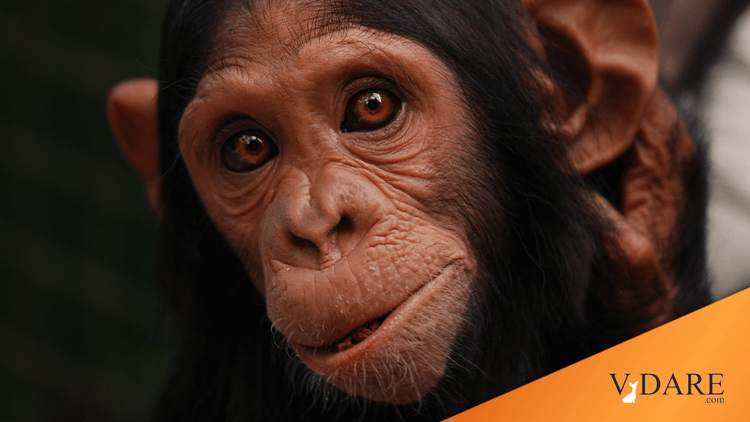
By Steve Sailer
07/27/2011
From my movie review in Taki’s Magazine:
Project Nim is a critically praised documentary about Nim Chimpsky, a chimpanzee who was the subject of one of those attempts to teach American Sign Language to an ape, a fad that once fascinated the popular imagination.
Directed by James Marsh, who won an Oscar for his 2008 documentary Man on Wire about another 1970s phenomenon — the French tightrope-walker who strolled from one World Trade Center tower to the other — Project Nim turns out to be an engaging, entertaining, manipulative, and characteristically lowbrow animal-rights polemic. Project Nim’s never-quite-articulated message is that chimpanzees should have been left in Africa. Perhaps, but there’s much this movie ignores.
Like the liberal college professor played by Ronald Reagan in Bedtime for Bonzo who raises a chimp like a child to show that nurture overrules nature, Columbia U. psychologist Herbert Terrace (Marsh’s designated villain) bought a baby male chimp in 1973 to prove Noam Chomsky wrong.
Read the whole thing there.
Let me add something about animals rights movements. Animal rights campaigners tend to be sentimental and illogical. The targets of their campaigns — e.g., medical laboratory heads, slaughterhouse owners, and so forth — are often their antitheses: logical and coldblooded.
But, the syntheses that emerge from their conflicts, the compromise solutions, are often better than either side alone. So, chalk one up for Hegel.
For example, we’ve learned an important lesson from the animal rights movement: don’t import more chimps. Moreover, Americans shouldn’t breed more chimps to use in entertainment. Young ones can be amazingly entertaining, but they live a long, long time, and the older they get, the cuter they ain’t. (That line, which I use a lot, is from one of my favorite Simpsons’ scripts, Lisa’s First Word by Jeff Martin.)
The full cost of caring for a chimp over a typical lifespan of maybe 40 or more years is huge. Don’t let private organizations privatize profits from chimps while socializing the costs they impose in the long run. (Funny how a lot of lessons learned from chimps can be applied more broadly.)
In medical research, don’t make chimps your automatic first choice. They often turn out to be of less use as human stand-ins than they would appear. For example, a lot were bred for AIDS research, but then it turned out that chimps infected with HIV rarely developed AIDS.
And they are gigantic amounts of work. For example, because they are miniature King Kongs who will rip your face off, Jim, you can’t, say, take blood from them without first shooting them with a tranquilizing dart gun.
White rats are often a lot better choice outside of a few disease like hepatitis where chimps are valuable.
This is a content archive of VDARE.com, which Letitia James forced off of the Internet using lawfare.